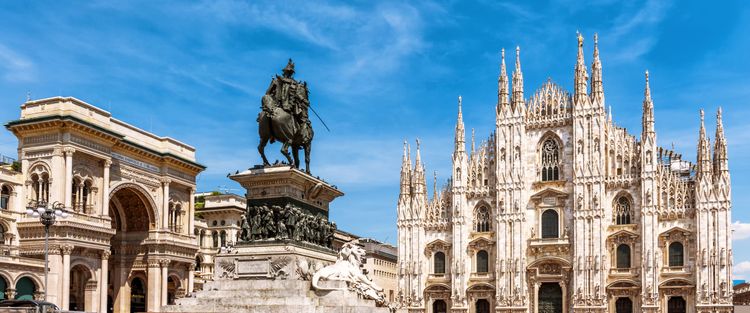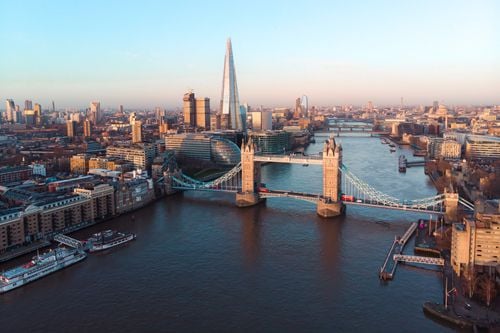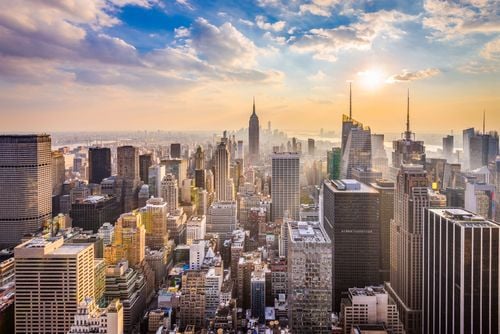This building was erected at the request of Francesco Sforza, who proclaimed himself lord of the town, during the 15th century. It was built on the remains of a previous medieval fortress. During its lifetime, the castle played host to a number of high society families, not all of them Italian. Members of foreign governments such as Charles V and Napoleon Bonaparte also stayed here.
The Sforza family castle, known in Italian as Castello Sforzesco, is the former residence of the Dukes of Milan. Built in the 15th century, it comprises several interior courtyards that are lavishly decorated with Renaissance arcades and sculptures. A sumptuous edifice that, despite a few disruptions, has retained its former splendour. On the death of Francesco II Sforza, the complex became a military camp and was the object of much covetousness before falling into a period of calm. The building has lost none of its importance, and remains a major historical monument in Milanese culture. The quadrilateral contains several areas, some of which are open to the public. These include a picture gallery, the archaeological museum, art galleries, a library and an archive centre. Immensely large, it stands proudly opposite the fountain in Piazza Castello.
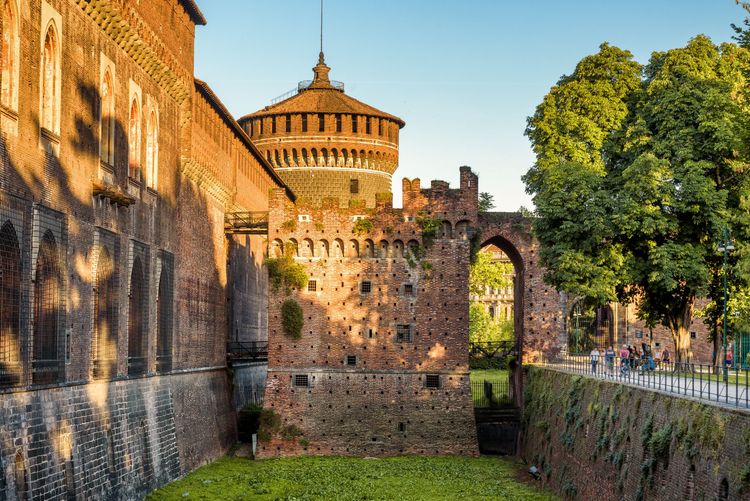
The Sforza castle with a close-up of one of the moats, Milan, Lombardy, Italy.
- © Viacheslav Lopatin / ShutterstockThe Lombard city in the Sforza era
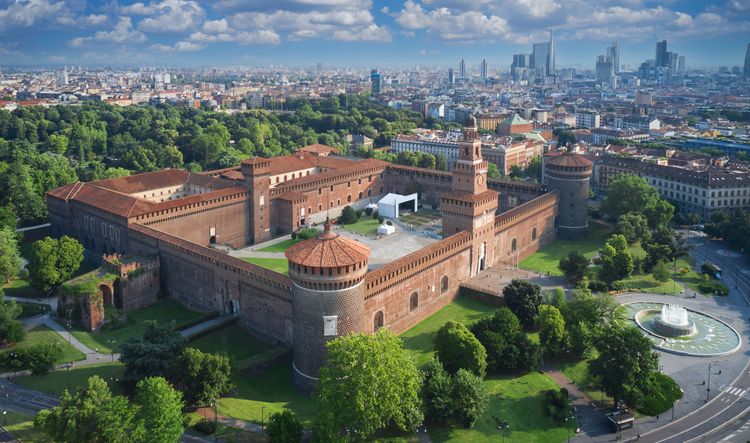
Aerial view of the former residence of the Dukes of Milan of the Sforza dynasty in Milan, Lombardy, Italy.
- © Andrea Berg / ShutterstockFrom 1815, the fortification became a military camp and a refuge for enemy Austrian troops who came to attack the city. After much debate, part of the monument was finally demolished and returned to its original form under the Sforza family. At its height, the fortress resembled a city within a city, where the officers and their servants lived. Kitchens, reception rooms, attics and even bakeries made up the building.
✈️ Flights to Milan
Just 1h20 from Paris, Milan is easily accessible by plane.A city within a city...
The first impression you get when you arrive in Piazza Castello is that of being infinitely small compared to this immense building. The Filarete tower faces the fountain on the esplanade and is the very first feature of the citadel. Adorned with red brickwork and attractive modenations, the tower is framed by two circular turrets. The quadrangle is surrounded by a moat and escorted by two towers on the town-side facade, which once contained water reservoirs.
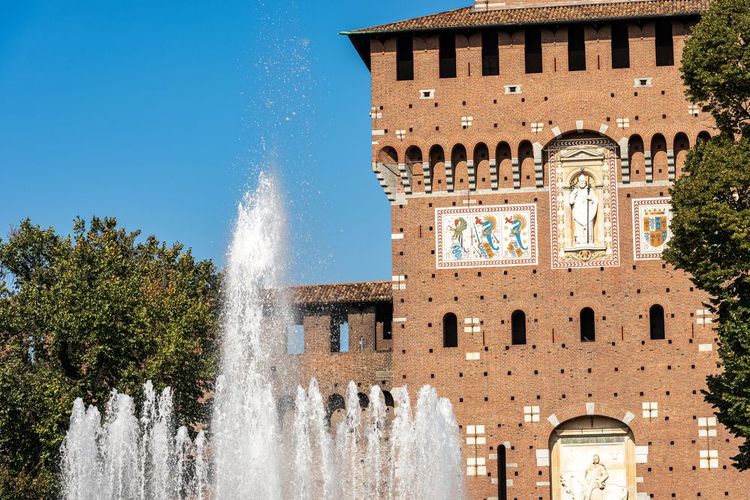
Close-up of the main facade of the Sforza Castle (Castello Sforzesco, 15th century), Piazza Castello, Lombardy, Italy, Europe.
- © Alberto Masnovo / ShutterstockOnce inside the complex, you arrive in a very large courtyard, the ducal courtyard, which leads to the various rooms to be visited. It would be a shame to stop here and miss the Rochetta, a fortress within a fortress: this is the Duke's former residence, no less! The rear façade features two square towers, the left of which is known as the Castellana tower. To find out more about this fortified complex, an audio tour of the Sforza fortress is available from €13.50 for 2 hours.
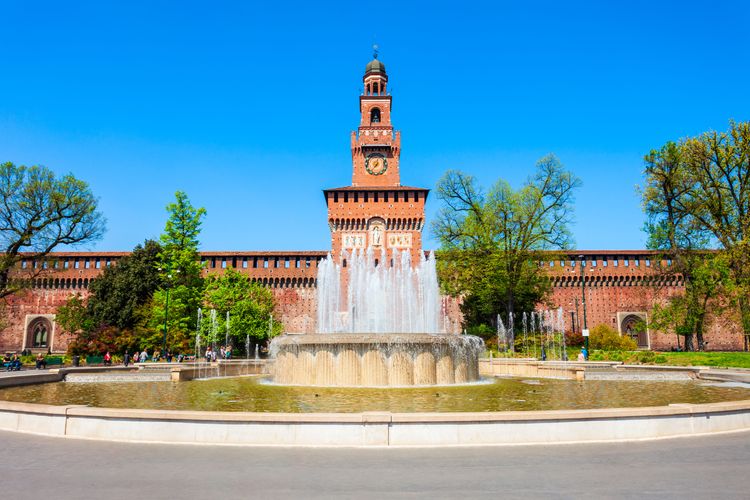
Sforza Castle or Castello Sforzesco is located in Milan, Lombardy, Italy.
- © saiko3p / ShutterstockAmong the must-see rooms is the Sala dell'Asse, where you can see part of the ancient fresco by the famous Leonardo da Vinci, a close friend of Ludovico Maria de Sforza, better known as 'Moro'. Initially, only a tiny piece of the fresco was visible, and it was only thanks to new excavations begun in 2013 that new fragments were discovered.
...but also a cultural venue
The Museum of Ancient Art is certainly the most important in the complex, housing engravings dating back to the Sforza family and sculpted works from Antiquity, the Middle Ages and the Renaissance. Among the most famous creations is the statue Pietà Rondanini, Michelangelo's very last work, which he was never able to finish...

Interior courtyard of the Sforza castle with one of the circular turrets, Milan, Lombardy, Italy.
- © Viacheslav Lopatin / ShutterstockThe castle's art gallery is on the first floor of the building and contains more than 1,500 works dating from the 13th to 18th centuries, including a range of frescoes painted by numerous artists from the regional school. For those with a passion for Egypt, there is a museum displaying funerary objects and... a few mummies to look at. There is also a Museum of Decorative Arts, which displays a large number of paintings on ceramics, the details of which are magnificent.
What to do around the castle
Sempione Park
Continue your exploration in the neighbouring garden: the Parc Sempione, one of the largest in Milan. Flowers, plants and trees intermingle in this green space. Inaugurated between 1890 and 1893, it is designed in the English style, leaving plenty of room for biodiversity, which is much appreciated in cities. The species and plants abound in this garden, which is particularly pleasant on hot summer days: it's a breath of fresh air for Milan.
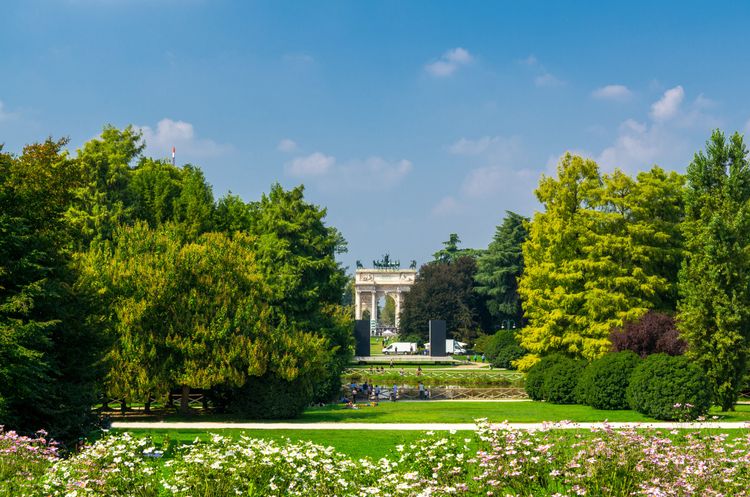
Peace Arch in Sempione Park, Milan, Lombardy, Italy.
- © Aliaksandr Antanovich / ShutterstockThere are a number of monuments in this natural setting, including the Triennale Design Museum in the Palazzo dell'Arte, which hosts temporary exhibitions. It changes several times a year. For more information, we recommend you take a look at the programme before you go.
Piazza Sempione
This square adjoins the park of the same name and is characterised by the Arch of Peace that stands at its centre. It is a fine example of Milan's neoclassical architecture. Built in 1807 to celebrate Napoleon's victories, it was finally completed in 1815. It is made of Baveno granite encased in Creola d'Ossola marble. At the top of the building, several bronze statues depict the Sestiga della Pace, accompanied by four Victories on horseback, while the front displays representations of the Italian rivers Po, Ticino, Adda and Tagliamento.
This square is one of the most popular places to enjoy an evening drink and a Milanese aperitivo. There are many establishments to choose from, including Capuanos, one of the best pizzerias. A pastry that's both soft and crispy, a generous layer of tomato sauce on top of which come a few slices of fresh mozzarella and garnished with a basil leaf... It's nirvana!
📍 Address: via Francesco Londonio, Milan
👛 Price: from €6
⏰Opening times: daily from noon to 3pm and from 7pm to midnight
Did you know?
Following numerous assaults by enemy troops, the famous Torre delle Filarete was reduced to dust in 1521. A French soldier is said to have accidentally detonated a bomb inside the turret (oops... the blunder!).
Practical information
🚌 How do I get there?
The castle is just a few minutes' walk from Piazza del Duomo. Getting there couldn't be easier, just do your best Italian accent and ask for "il Castello Sforzesco, per favore".
📍 Address:
Piazza Castello, 20121 Milano
👉 Tickets:
Possibility to buy your ticket online to avoid queuing or on site from Tuesday to Sunday from 10am to 4.30pm.
⏰ Opening times:
Castle: Tuesday to Sunday, 7am to 7.30pm, except on 1 January, 1 May and 25 December.
Museums and exhibitions: Tuesday to Sunday, 10am to 5.30pm (last admission at 5pm).
👛 Admission:
Visiting the castle is free (in the courtyards) but access to the galleries inside the building is chargeable. Tickets cost €5 for adults and €3 for concessions.
Where to get a good ice cream?
Because the capital of Lombardy is also a great place to enjoy a really good ice cream, artisan ice cream maker RivaReno is offering a selection of ice cream delights to take away in a cone or a small tub. Naturally generous, the ice creams are intensely flavoursome and contain no artificial additives.
Where to sleep?
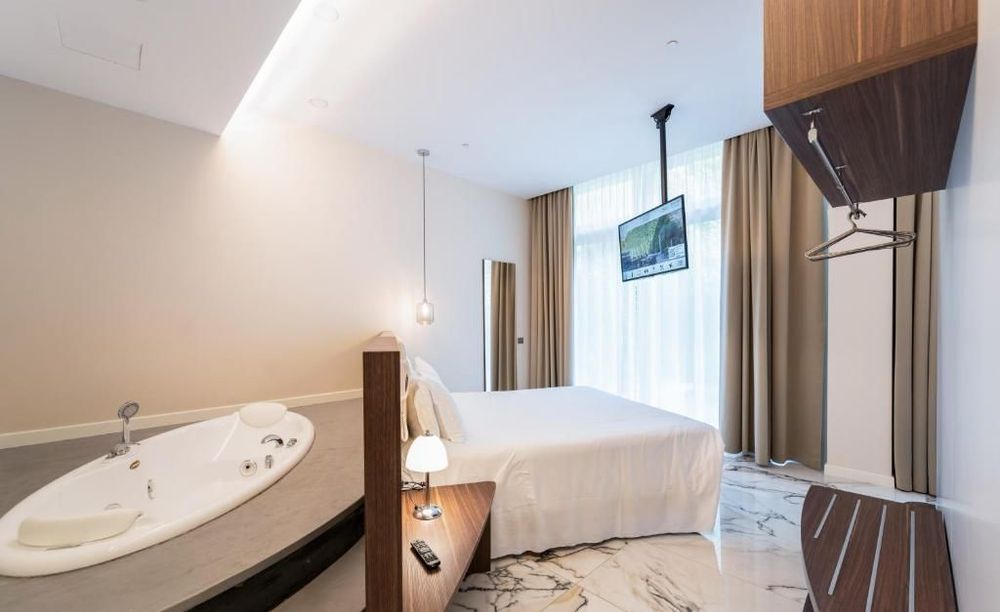 Milan
Milan
